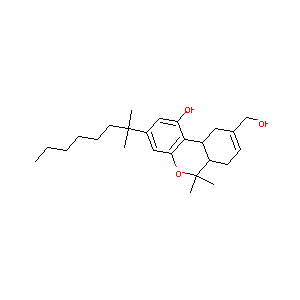Details of the Drug
General Information of Drug (ID: DMRH291)
| Drug Name |
Dexanabinol
|
|||||||||||||||||||
|---|---|---|---|---|---|---|---|---|---|---|---|---|---|---|---|---|---|---|---|---|
| Synonyms |
Sinnabidiol; HU 211; HU-211; PRS 211007-000; (6aS,10aS)-9-(hydroxymethyl)-6,6-dimethyl-3-(2-methyloctan-2-yl)-6a,7,10,10a-tetrahydrobenzo[c]chromen-1-ol; 1,1-Dimethylheptyl-11-hydroxytetrahydrocannabinol; 1,1-Dimethylheptyl-7-hydroxy-delta(6)-tetrahydrocannabinol; 11-Hydroxy-delta(8)-tetrahydrocannabinol-dimethylheptyl; 11-Hydroxy-delta-8-dmh-thc; 11-Hydroxymethyl-delta(8)-tetrahydrocannabinol-dimethylheptyl; 11-OH-delta(8)-Thc-dmh; 5'(1,1-Dimethylheptyl)-7-hydroxyhexahydrocannabinol; 7-Hydroxy-delta-6-tetrahydrocannabinoldimethylheptyl
|
|||||||||||||||||||
| Indication |
|
|||||||||||||||||||
| Drug Type |
Small molecular drug
|
|||||||||||||||||||
| Structure |
 |
|||||||||||||||||||
| 3D MOL | 2D MOL | |||||||||||||||||||
| #Ro5 Violations (Lipinski): 1 | Molecular Weight (mw) | 386.6 | ||||||||||||||||||
| Topological Polar Surface Area (xlogp) | 6.4 | |||||||||||||||||||
| Rotatable Bond Count (rotbonds) | 7 | |||||||||||||||||||
| Hydrogen Bond Donor Count (hbonddonor) | 2 | |||||||||||||||||||
| Hydrogen Bond Acceptor Count (hbondacc) | 3 | |||||||||||||||||||
| Chemical Identifiers |
|
|||||||||||||||||||
| Cross-matching ID | ||||||||||||||||||||
Molecular Interaction Atlas of This Drug
 Drug Therapeutic Target (DTT) |
|
||||||||||||||||||||||||||
|---|---|---|---|---|---|---|---|---|---|---|---|---|---|---|---|---|---|---|---|---|---|---|---|---|---|---|---|
| Molecular Interaction Atlas (MIA) | |||||||||||||||||||||||||||
References
